IMAX 7OMM at the TLC
Chinese Theatre |
Read more at in70mm.com The 70mm Newsletter |
| Written by: Kurt Wahlner, Hollywood, USA. Publisher of graumanschinese.org | Date: 23.08.2023 |
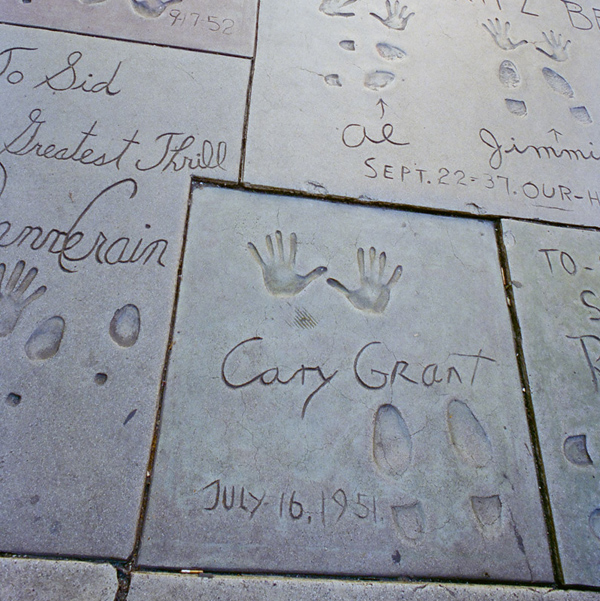 Cary
Grant's hand- and footprint from July 16, 1951 in the Chinese Theatre
Forecourt. Picture: Thomas Hauerslev (1994). Cary
Grant's hand- and footprint from July 16, 1951 in the Chinese Theatre
Forecourt. Picture: Thomas Hauerslev (1994). While the Chinese Theatre in Hollywood, California is known around the world for its collection of footprints of famous film personalities, it is also known for its incredible screen and sound system. Conceived by theatre impresario Sid Grauman as a companion house to his Egyptian Theatre in Hollywood, the enormous theatre was constructed by the Meyer and Holler construction company and designed by their lead architect Raymond Kennedy. Opened on May 18, 1927 with a star-studded premiere of Cecil B. DeMille’s silent swan-song “The King of Kings” the film was preceded by a Grauman-produced stage prologue of incredible lavishness. • Go to gallery "Oppenheimer" in IMAX 7OMM at the TLC Chinese Theatre Mr. Grauman, showman to the end, was happy to keep the exact origins of the Forecourt footprints a mystery. Several legends vie for the “real” story, but the most likely version is that while building the Egyptian Theatre down the street, Grauman saw mason Jean Klossner “sign” his work on the building by leaving his handprint in some cement. Grauman ran with this idea, developing into the Forecourt ritual we know today. The Chinese Theatre was designed to have a large, wide Forecourt to accommodate these cement mementos of film personalities, all of whom (until his death in 1950) were chosen by Sid Grauman. Klossner developed a concrete smooth enough for imprints and writing, but hard enough to withstand heavy traffic over time. Klossner executed almost all the blocks prior to 1953. Although the blocks done today are smaller, there is still room for many more. The current count is 310 people imprinted since 1927. |
More in 70mm reading: 70mm Cinemas in North America Films shown in 70mm in Los Angeles, CA, USA 70mm cinemas in Southern California in70mm.com's Library Presented on the big screen in 7OMM Peripheral Vision, Scopes, Dimensions and Panoramas |
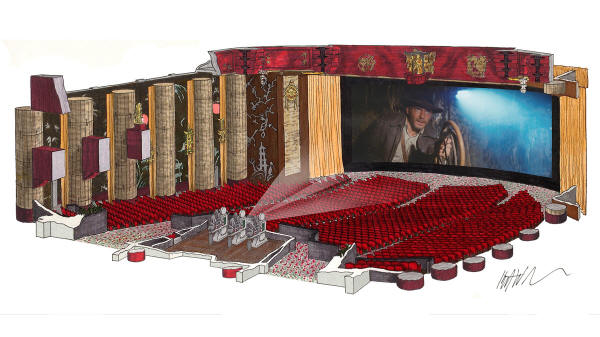 The
original Grauman's Chinese Theatre as illustrated by Kurt Wahlner. The
original Grauman's Chinese Theatre as illustrated by Kurt Wahlner.Long before the Cinerama Dome began to vie for movie-goer’s attention, the Chinese premiered 20th Century Fox’s CinemaScope process on a proscenium-filling screen 62 feet wide and 24 feet tall (18,9 m x 7,3 m). After that, the owners of the theatre decided to make their own super spectacle film called "Windjammer" filmed in that well-known format, Cinemiracle. To show “Windjammer” on as large a screen as possible, it was decided to remove the entire stage, including the wings, and install a very large curved screen in the center of where the stage used to be. The new Cinemiracle screen is estimated to be able to show the film a staggering 92 feet wide by 36 feet tall. Unhappily, Cinemiracle failed to catch on, so it was decided to convert the theatre’s projection systems to the 70mm format toward the end of 1959. These, of course, were heady times for 70mm, and the Chinese didn't want to be left out. This meant installing state-of-the-art equipment, to provide patrons with an experience unavailable elsewhere. The huge Cinemiracle screen as well as the sound delivery system was already impressive. But what about the projectors? |
|
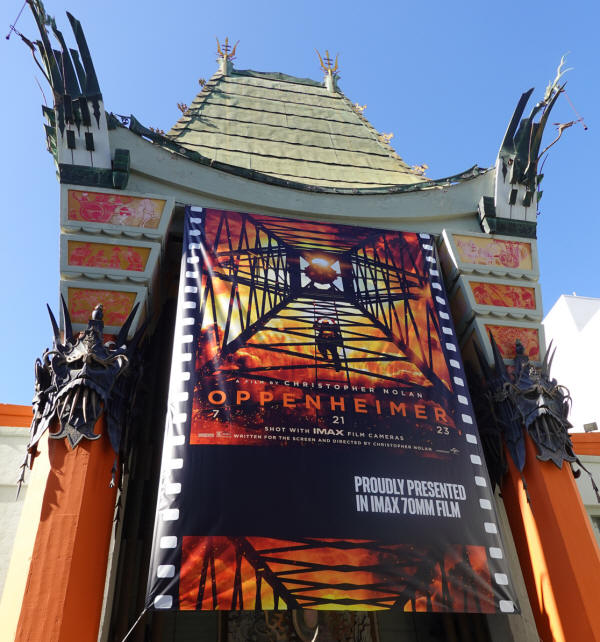 The
TLC Chinese Theatre IMAX dressed for "Oppenheimer" in 70mm IMAX seen
2023.08.13. Photo: Paul Rayton The
TLC Chinese Theatre IMAX dressed for "Oppenheimer" in 70mm IMAX seen
2023.08.13. Photo: Paul RaytonAnd for this, they turned to "The Todd-AO Projector" the DP70, manufactured by the Phillips Corporation of Holland. After the end of the “Windjammer” engagement in December, 1958, conventional 35mm films booked into the theatre were run off on three Simplex XL projectors in the “upstairs” booth, while the booth built at the rear of the orchestra floor to accommodate the Cinemiracle apparatus sat quietly, awaiting the return of the process. When that didn’t happen, and the Cinemiracle process was sold to Cinerama in January, 1960, The Chinese began the process of clearing the “downstairs” booth out, while retaining all of the RCA amp racks and the Ashcraft Super Cinex lamphouses to use with the DP70s coming in. The first film to play the Chinese in 70mm was a re-issue of “The King and I” in May, 1961. Billed as a “Grandeur 70” film, “King” got a “Gala West Coast Premiere” attended by a newer group of stars than usual: Frankie Avalon, Barbara Eden and Paula Prentiss. The old “upstairs” booth was converted into a VIP private seating area. The three Norelcos got a mighty good workout later in 1961 when “West Side Story” opened at the Chinese in December. The popular film played reserved seats anywhere from 10 to 14 showings a week for a record 57 weeks, closing mid January 1963. When the film was presented on its 50th anniversary and the imprinting of cast members Rita Moreno, George Chakiris and Russ Tamblyn in November 2011 - sorry - digital! Things continued along after that, with long runs for 70mm films like “Chitty Chitty Bang Bang” and “Hello, Dolly!” A special re-issue of “House of Wax” was shown in a 70mm system where the stereo images were placed side-by-side in the frame accompanied by a vigorous 6-channel stereo mix. Due to the extraordinary height of the screen, the 1:1.33 film was shown at a very large size to match the soundtrack. It was around this engagement that the Super Cinex lamphouses were replaced with ORC Xenon lamphouses. |
|
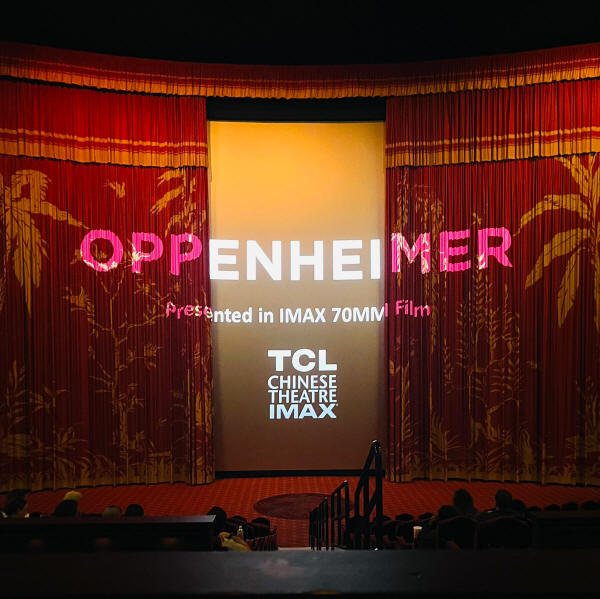 Curtains
opening for "Oppenheimer" in 7OMM IMAX on 18. august 2023. Image by Jeff
Yorkes Curtains
opening for "Oppenheimer" in 7OMM IMAX on 18. august 2023. Image by Jeff
YorkesDuring the second edition of FILMEX held in November, 1972, the archivists at the Disney Studio dug up a runnable 70mm print of “Sleeping Beauty” shown on November 18, 1972 - in a film festival running ten days and presenting hundreds of films, “Sleeping Beauty” became an instant sellout; the hottest ticket at the festival. After playing the 70mm re-issue of “Gone with the Wind” in 1975 and 1976’s “A Star is Born” somebody at Mann Theatres booked a film called “Star Wars” and everything changed. No one was prepared for what “Star Wars” had in store for them: Groundbreaking special effects, one of the greatest symphonic scores ever written for a film, and a soundtrack which was not only innovative sonically, but also from a delivery standpoint: what came to be known as 70mm Dolby System “baby boom.” We all know that 70mm generally at the time had five channels behind the screen and one channel for the surrounds. Since the Dolby people were moving toward only three speakers behind the screen and one channel for surround, what do you do with the two channels behind the screen not being used? The answer was to use these tracks for low-frequency effects - the first film to use this technique in recorded tracks (and not the mechanically generated rumble used for “Earthquake”). Since “Star Wars” originally opened in only eight US theatres in 70mm, George Lucas and his team could concentrate on making each one sound as good as possible. Since the Voice of the Theatre speakers at the Chinese could go exceptionally low, they were probably relied on to produce the low end effects coming out of channels 2 and 4. This format would eventually become known as “Format 42.” |
|
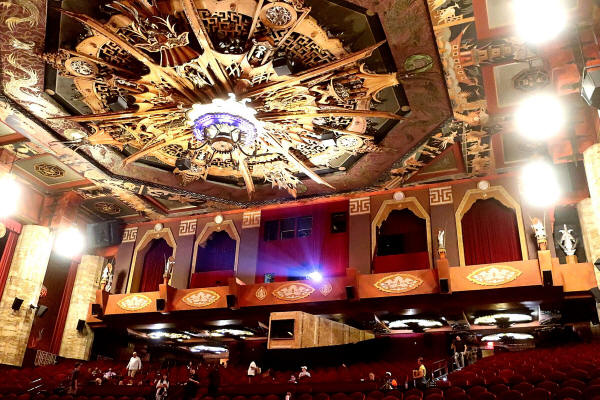 The
TLC Chinese Theatre IMAX with temporary IMAX 70mm projection room (under the
beam of light) seen 2023.07.11. Photo: Bill Counter. The
TLC Chinese Theatre IMAX with temporary IMAX 70mm projection room (under the
beam of light) seen 2023.07.11. Photo: Bill Counter.While it is true that the projectionists at the Chinese built up the reels to full capacity so that the whole movie fit onto three reels (not so many change-overs to do, dear boy), it was close to the last of feature films being shown “reel to reel” at the Chinese. Like “Hell’s Angels” before it, “Star Wars” made no mention of its “baby boom” effects; but it was there, waiting just below the surface, to blast audiences with what came to be known as “low frequency effects.” In addition to everything else unique about “Star Wars,” people came back again and again to experience the film in 70mm at the Chinese - with its huge screen, great sound system, boomy acoustics and exotic decor - the film and the theatre were a perfect match. There were other theatres in the Los Angeles area playing the picture in 70mm, but the Chinese became the shrine of the “Star Wars” experience, where it played for almost an entire year, and continues to host all of the new “Star Wars” features even today. With every producer in Hollywood chasing the “Star Wars” daydream of box-office success, business soared to such a point at the Chinese that a pair of 700 seat theatres (not so affectionately called “The Chinese Twins”) were opened in April 1979. In order to have fewer projectionists run all the shows in all three theatres, 35/70 platters were installed. |
|
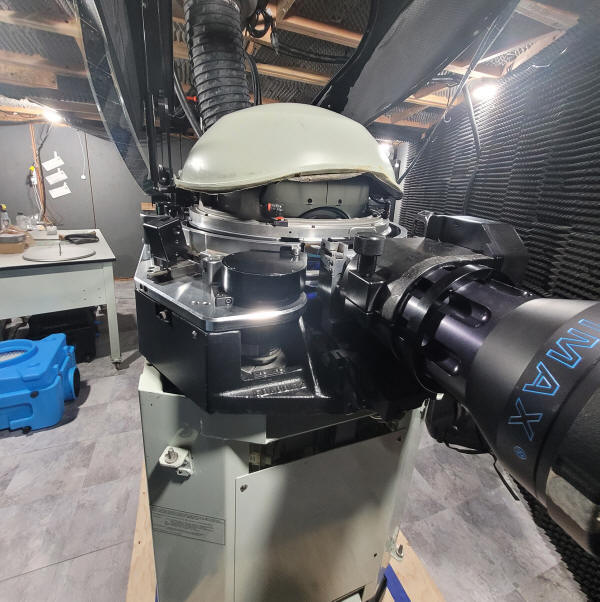 The
TLC Chinese Theatre SR IMAX 70mm projector for "Oppenheimer" in 70mm IMAX
seen 2023.07.16. Photo: Pat Caldwell The
TLC Chinese Theatre SR IMAX 70mm projector for "Oppenheimer" in 70mm IMAX
seen 2023.07.16. Photo: Pat CaldwellBy the time “Superman: The Movie” opened at the Chinese in December 1978, Dolby engineers were cooking up a way to get two channels of surround material out of a 70mm print, in what came to be known as “Format 43” - Split Stereo. but the Chinese didn’t get to play “Superman: The Movie” in Format 43. That would have to wait until May 1986, when the theatre played host to “Top Gun” - for a whole week. After George Lucas as his sound crews decided to “standardize” theatres and their acoustics with the THX and TAP programs, the Chinese - improbably some thought - became the flagship for the THX program. New JBL speakers were embedded into a “THX Wall”” and every effort was made to deaden the house acoustically, but as can be imagined, there was no way that the Chinese, originally designed for transmission of the voice and musical instruments without amplification, could be made to have the dead reverb specs of a mixing stage at Skywalker Ranch. But audiences went along with it anyway. The “Deep Note” bellowed through the theatre from “Indiana Jones and The Temple Of Doom” in 1984 to “The Warrior’s Way” in December 2010. In order to compete for box-office dollars the theatre decided to take a gamble and convert the place into an IMAX theatre. After promising preservationists not to touch anything from the theatre’s unique (and antique) decor, the floor was dug out so that the IMAX screen (still following the contour curve of the Cinemiracle screen) could extend into the trap room under the old stage, creating a screen 87 feet wide by 50 feet high (26,5 m x 15,2 m). Throw is 110 feet (33,5 m). The auditorium floor was jackhammered up and removed through one small door at the rear of the stagehouse, and steps for stadium seating were installed (880 seats). A two story projection room was constructed: the lower floor for the IMAX digital projectors and the upstairs for the conventional digital projectors. |
|
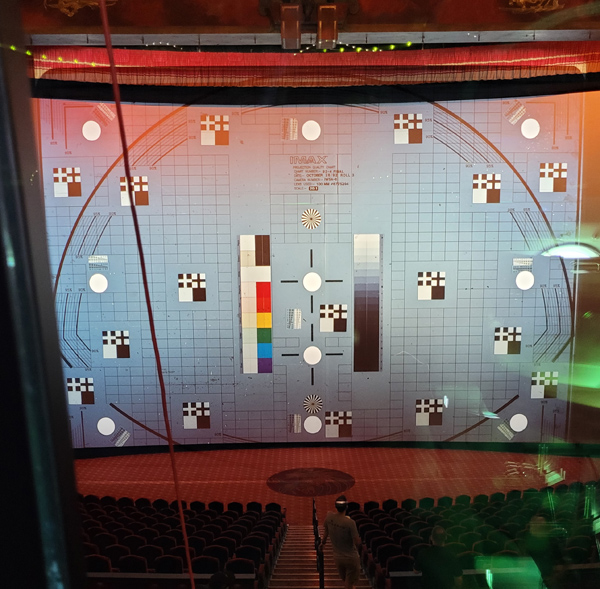 The
TLC Chinese Theatre screen with IMAX 70mm alignment film preparing for "Oppenheimer". Photo: Pat Caldwell The
TLC Chinese Theatre screen with IMAX 70mm alignment film preparing for "Oppenheimer". Photo: Pat CaldwellAnd it is important to remember that the size of the booth on either floor of the Chinese has always been considered rather small. When Christopher Nolan wanted his film “Interstellar” to play at the Chinese on 70mm film, The Chinese was ready: The two IMAX digital projectors in the lower booth were re-installed on tracks which could move them to the left of their projection port windows. An IMAX SR projector was brought in, a REALLY BIG platter was installed to run the 11.5 mile long print of the film, AND the screen is the only IMAX theatre in the world with adjustable side masking, so that the film could be run in the old 15-perf IMAX shape. The film opened in November 2014, and did some pretty big numbers, so people were a bit perplexed when Nolan’s next film, “Dunkirk” had to play the Chinese in IMAX digital. And there was a simple reason for this. In March 2015, a pair of IMAX Laser digital projectors were installed on the lower level booth. These projectors are so large that they were not placed on tracks for moving. Without being able to move these units out of the way or remove them altogether (some of the hallway walls had to be removed in order to get them in in the first place), "Dunkirk" would just have to settle for IMAX digital. Which is why when it came time for the Chinese Theatre to play Nolan’s next film "Oppenheimer", an IMAX projector couldn’t be installed in the lower booth, while installing it in the upper booth would result in unacceptable keystoning; too high up. Besides, "Oppenheimer" is even longer than “Interstellar;” a print of “Oppenheimer” is 11.5 miles long (18,5 km) and weighs 600 pounds. |
|
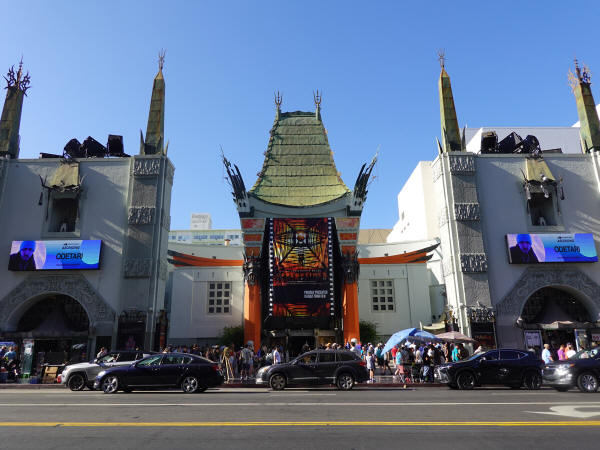 The
TLC Chinese Theatre IMAX dressed for "Oppenheimer" in 70mm IMAX seen
2023.08.13. Photo: Paul Rayton The
TLC Chinese Theatre IMAX dressed for "Oppenheimer" in 70mm IMAX seen
2023.08.13. Photo: Paul RaytonIt was decided to build a temporary booth at the rear of the orchestra floor. Seats were removed and a soundproofed booth large enough to contain an IMAX SR projector and the platter (enlarged ever so slightly with cute little expansion rings to hold the bigger print), makeup table, some controls and so on was constructed. All the power for this enterprise was run out of the lower booth windows, and another set of sound cables was run from the temp booth up to the IMAX amp racks in the lower booth. Projectionists Patrick Caldwell and Charlie Moss were brought out from the East Coast to help with the installation and to run the shows for three weeks. But as we know, “Oppenheimer” in 70mm IMAX has become a thing. Audiences have come to realize that this format is the best way to see this unique film, and of them, the Chinese is easily the best place to do that. Ticket sales have been nothing short of astounding, with the theatre playing the picture 5 times a day on the weekends, starting with a 6:00 AM show (IMAX usually shows up to buy everyone coffee). Patrick and Charlie like Los Angeles and Hollywood and stuff, but getting back to their families is on hold for the time being: “Oppenheimer” is set to run until the end of August, so instead of playing for three weeks, it will wind up playing for eight weeks, and ticket sales are still very strong. None of this watching the movie with ten or twenty others; every show is PACKED. When it comes time to close it at the end of August, shows will sell out with people doing a repeat viewing. To maintain a pristine appearance, the “Oppenheimer” print was replaced with a new one over the weekend of August 18th. In fact, there does not seem to be any plans to remove the temporary booth with its projector and platter. Perhaps they will allow the booth to remain until the next director with a big imagination has a film to make in IMAX 15-perf. |
|
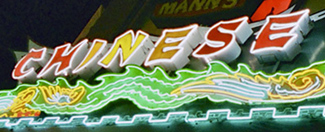 • Go to IMAX 7OMM at the TLC Chinese Theatre |
|
| Go: back - top - back issues - news index Updated 21-01-24 |
